- Clone
- H194-112 (See other available formats)
- Regulatory Status
- RUO
- Other Names
- Dipeptidyl peptidase 4, THAM
- Isotype
- Rat IgG2a, κ
- Ave. Rating
- Submit a Review
- Product Citations
- publications
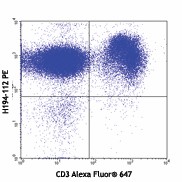
-

C57BL/6 splenocytes stained with H194-112 PE and CD3 (17A2) Alexa Fluor® 647
| Cat # | Size | Price | Quantity Check Availability | Save | ||
|---|---|---|---|---|---|---|
| 137803 | 25 µg | $117 | ||||
| 137804 | 100 µg | $238 | ||||
CD26, also known as DPP IV or THAM, is a 220 kD type II transmembrane homodimer. It consists of an α/β hydrolase domain and an eight-blade beta-propeller domain. After proteolysis of the membrane-bound CD26, a soluble form of DPP IV is released. CD26 is expressed on thymocytes (development dependent), T cells, B cells, NK cells, and macrophages. It is involved in T cell costimulation, endothelial cell migration and proteolysis processes.
Product DetailsProduct Details
- Verified Reactivity
- Mouse
- Antibody Type
- Monoclonal
- Host Species
- Rat
- Immunogen
- BALB/c thymocytes
- Formulation
- Phosphate-buffered solution, pH 7.2, containing 0.09% sodium azide.
- Preparation
- The antibody was purified by affinity chromatography and conjugated with PE under optimal conditions.
- Concentration
- 0.2 mg/ml
- Storage & Handling
- The antibody solution should be stored undiluted between 2°C and 8°C, and protected from prolonged exposure to light. Do not freeze.
- Application
-
FC - Quality tested
- Recommended Usage
-
Each lot of this antibody is quality control tested by immunofluorescent staining with flow cytometric analysis. For flow cytometric staining, the suggested use of this reagent is ≤1.0 µg per million cells in 100 µl volume. It is recommended that the reagent be titrated for optimal performance for each application.
- Excitation Laser
-
Blue Laser (488 nm)
Green Laser (532 nm)/Yellow-Green Laser (561 nm)
- Application Notes
-
Additional reported applications include: in vitro activation of thymocytes1, immunoprecipitation from cell lysates and cell-free supernatants1,2 and immunohistochemical staining of frozen tissue sections1.
-
Application References
(PubMed link indicates BioLegend citation) - Product Citations
-
- RRID
-
AB_2093729 (BioLegend Cat. No. 137803)
AB_2293047 (BioLegend Cat. No. 137804)
Antigen Details
- Structure
- Homodimer, each monomer is a single chain type II transmembranal molecule of 110 kD that consists of two domains; soluble form is released after proteolysis of the membrane form
- Distribution
-
Mature thymocytes, activated T cells, B cells, NK cells, macrophages
- Function
- T cell costimulation, endothelial cell migration, proteolysis
- Interaction
- CAV1, IGF2R, PTPRC, BCL10, CARD1, IKBKB
- Ligand/Receptor
- ADA, collagen
- Cell Type
- B cells, Macrophages, NK cells, T cells, Thymocytes
- Biology Area
- Immunology, Costimulatory Molecules
- Molecular Family
- Adhesion Molecules, CD Molecules
- Antigen References
-
1. Cooper KG, et al. 2009. Infect. Immun. 77:2447.
2. Eltzschig HK, et al. 2006. Blood 108:1602.
3. Peranteau WH, et al. 2006. Blood 108:4268. - Gene ID
- 13482 View all products for this Gene ID
- UniProt
- View information about CD26 on UniProt.org
Related FAQs
- What type of PE do you use in your conjugates?
- We use R-PE in our conjugates.
Other Formats
View All CD26 Reagents Request Custom Conjugation| Description | Clone | Applications |
|---|---|---|
| Purified anti-mouse CD26 (DPP-4) | H194-112 | FC,IP,IHC-F |
| APC anti-mouse CD26 (DPP-4) | H194-112 | FC |
| FITC anti-mouse CD26 (DPP-4) | H194-112 | FC |
| PE anti-mouse CD26 (DPP-4) | H194-112 | FC |
| PE/Cyanine7 anti-mouse CD26 (DPP-4) | H194-112 | FC |
| TotalSeq™-A0883 anti-mouse CD26 (DPP-4) | H194-112 | PG |
| TotalSeq™-B0883 anti-mouse CD26 (DPP-4) | H194-112 | PG |
| TotalSeq™-C0883 anti-mouse CD26 (DPP-4) | H194-112 | PG |
Customers Also Purchased
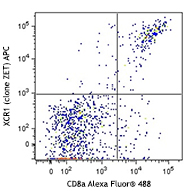
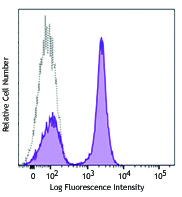
Compare Data Across All Formats
This data display is provided for general comparisons between formats.
Your actual data may vary due to variations in samples, target cells, instruments and their settings, staining conditions, and other factors.
If you need assistance with selecting the best format contact our expert technical support team.
-
Purified anti-mouse CD26 (DPP-4)
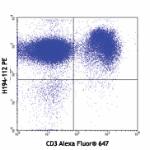
C57BL/6 splenocytes stained with purified H194-112 conjugat... -
APC anti-mouse CD26 (DPP-4)
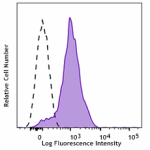
C57BL/6 splenocytes were stained with CD26 (DPP-4) (clone H1... -
FITC anti-mouse CD26 (DPP-4)
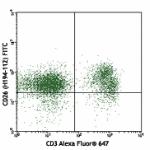
Balb/c splenocytes stained with anti-mouse CD26 (H194-112) F... -
PE anti-mouse CD26 (DPP-4)

C57BL/6 splenocytes stained with H194-112 PE and CD3 (17A2) ... -
PE/Cyanine7 anti-mouse CD26 (DPP-4)
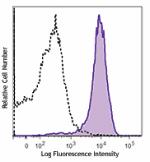
C57BL/6 splenocytes were stained with CD26 (clone H194-112) ... -
TotalSeq™-A0883 anti-mouse CD26 (DPP-4)
-
TotalSeq™-B0883 anti-mouse CD26 (DPP-4)
-
TotalSeq™-C0883 anti-mouse CD26 (DPP-4)
 Login/Register
Login/Register 










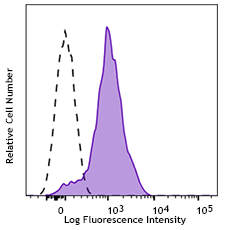
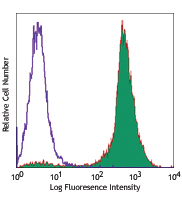



Follow Us